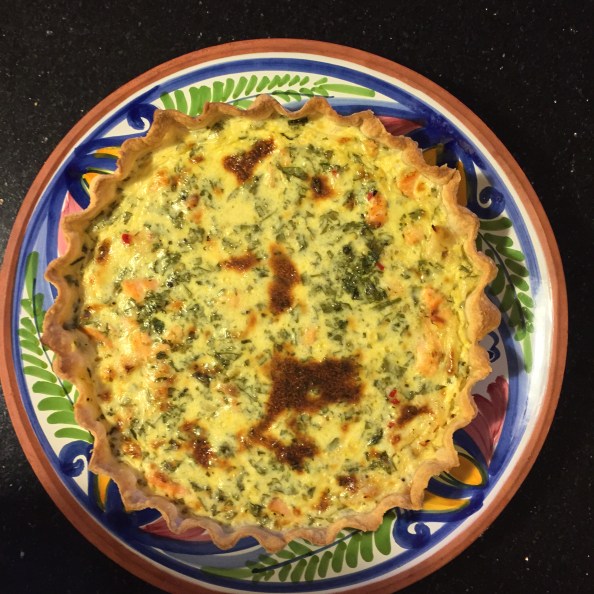
Making tarts or quiches in an Aga could not be easier because you do not have to bake the pastry blind. Take the tart above, which I made on Friday. I used this recipe by Diana Henry but was able to omit several stages and go straight from chilling the lined tart tin to adding the filling and baking it.
On this occasion I didn’t even make the pastry myself. I bought some good quality all butter shortcrust in sheets, which meant minimal rolling out was required. Once I’d lined my tin with it, I put it in the freezer to firm up, as Diana advises, but I did not prick the pastry with a fork; this is not necessary if you are not baking it blind.
I’m not sure how long mine was in the freezer for, but probably no longer than half an hour. I did a bit of washing up (I’m one of those cooks who clears up as she goes along) and prepared the filling while this was happening. So then all I had to do was put the crab/salmon/Thai ingredients in the pastry case and pour over the cream/egg mixture and cook my tart. This I did by placing it straight onto the floor of the Aga roasting oven and leaving it there for about thirty-five minutes. I checked on it after twenty though. It was done when the filling was golden and no longer wobbly. I removed it and let it rest while I roasted some new season English asparagus to go with it. A nice green salad would have been a good accompaniment too. We thought this tart was delicious. I have resolved to make more such things during the summer. A tart makes excellent picnic food and if you have any left over, it keeps well in the fridge and is available for any peckish moments. I’ve just remembered a rather delicious smoked salmon one I used to make. Must dig out the recipe.
On Saturday I did absolutely no cooking, which was a treat. We were in London for the day and went out for a lovely family lunch at our favourite Italian restaurant, fittingly called La Famiglia. The reason for the gathering was that one of my cousins had come over from Norway to visit his aunt, my mother. All my boys were able to join us and together with one girlfriend and one fiancée there were ten of us round the table. My husband, youngest son and I didn’t get back to Bristol until about 8.30 in the evening (in time to catch most of Eurovision). We weren’t really hungry but managed to squeeze in a little slice of the tart all the same.
On Sunday afternoon I made scones for afternoon tea. I cannot think of anything quicker to bake than scones and I just love them. The recipe I chose was this one by Thane Prince which uses buttermilk. The scones are light and not at all rich. If you want a richer scone, there are plenty of recipes which use eggs, like this Mary Berry one.
Update: BBC Food Website
Following the devastating news today that the BBC is to remove all 11,000 recipes from its food website, I need to update this post. The Mary Berry scone recipe link above will soon no longer function. It was probably a bit lazy of me merely to give you a link anyway, so I’m giving you below one of her scone recipes in full. It’s one I’ve used many times. And don’t worry, I have no plans to remove any recipes from my blog so it will be here for you to use forever!
Mary Berry’s Very Best Scones
- Makes about 20
- Pre-heat conventional oven to 220ºC
- You will need two large baking trays, lightly greased or lined with bake-o-glide
Ingredients
- 450g SR flour
- 2 rounded teaspoons baking powder
- 75g butter, at room temperature
- 50g caster sugar
- 2 large eggs
- about 225 ml milk
Method
- Sieve the flour and baking powder into a large bowl and rub the butter into it with your fingertips, until it resembles fine breadcrumbs. You can pulse this in a food processor if you prefer
- Stir in the sugar (and pulse again if using food processor)
- Beat the eggs together and make up to a generous 300ml with the milk, then reserve 2 tablespoons of this for glazing the scones later
- Gradually add the egg mixture to the dry ingredients, stirring it in until you have a soft dough. Again, this can be done in a processor
- The mixture should be on the wet side, sticking to your fingers, as the scones will rise better
- Tip the dough onto a lightly floured surface and flatten it out with your hand to a thickness of 1-2 cms. Use a 5cm fluted cutter to stamp out the scones by pushing the cutter straight down into the dough (as opposed to twisting it), then lifting it straight out
- Gently push the remaining dough together, knead very lightly, then re-flatten (you could use a rolling pin) and cut out more scones
- Arrange the scones on the baking trays and brush the tops with the reserved beaten egg mixture to glaze
- Bake, one tray at a time, with the tray on the third rung in the Aga roasting oven, or in the pre-heated conventional oven, for 10-15 minutes, until well risen and golden
- Transfer to a wire rack and leave to cool
















